Strategic Management Report: GM's Organizational Restructure Analysis
VerifiedAdded on 2022/09/09
|11
|2236
|24
Report
AI Summary
This report examines the organizational structure of General Motors (GM), focusing on its current regional segmentation model and its impact on the company's performance. The analysis highlights the challenges of inconsistent marketing campaigns and a lack of centralized supervision, leading to potential issues in branding and communication with customers. The report proposes a restructuring plan that shifts towards a more centralized management system to improve consistency in promotional activities and enhance the ability to monitor regional operations. The proposed structure involves continuous reporting and exchange of decisions between regional heads and the headquarters. Furthermore, the report evaluates the restructure plan, addressing potential resistance from stakeholders and suggesting interventions such as clear communication and negotiation to ensure successful implementation. The report emphasizes the importance of stakeholder engagement and the need for product differentiation through branding and promotional activities within the restructured framework. The analysis also includes figures illustrating both the current and proposed business structures, providing a comprehensive overview of the strategic recommendations. The report concludes by emphasizing the need for a centralized structure to improve organizational position and competitive advantage.
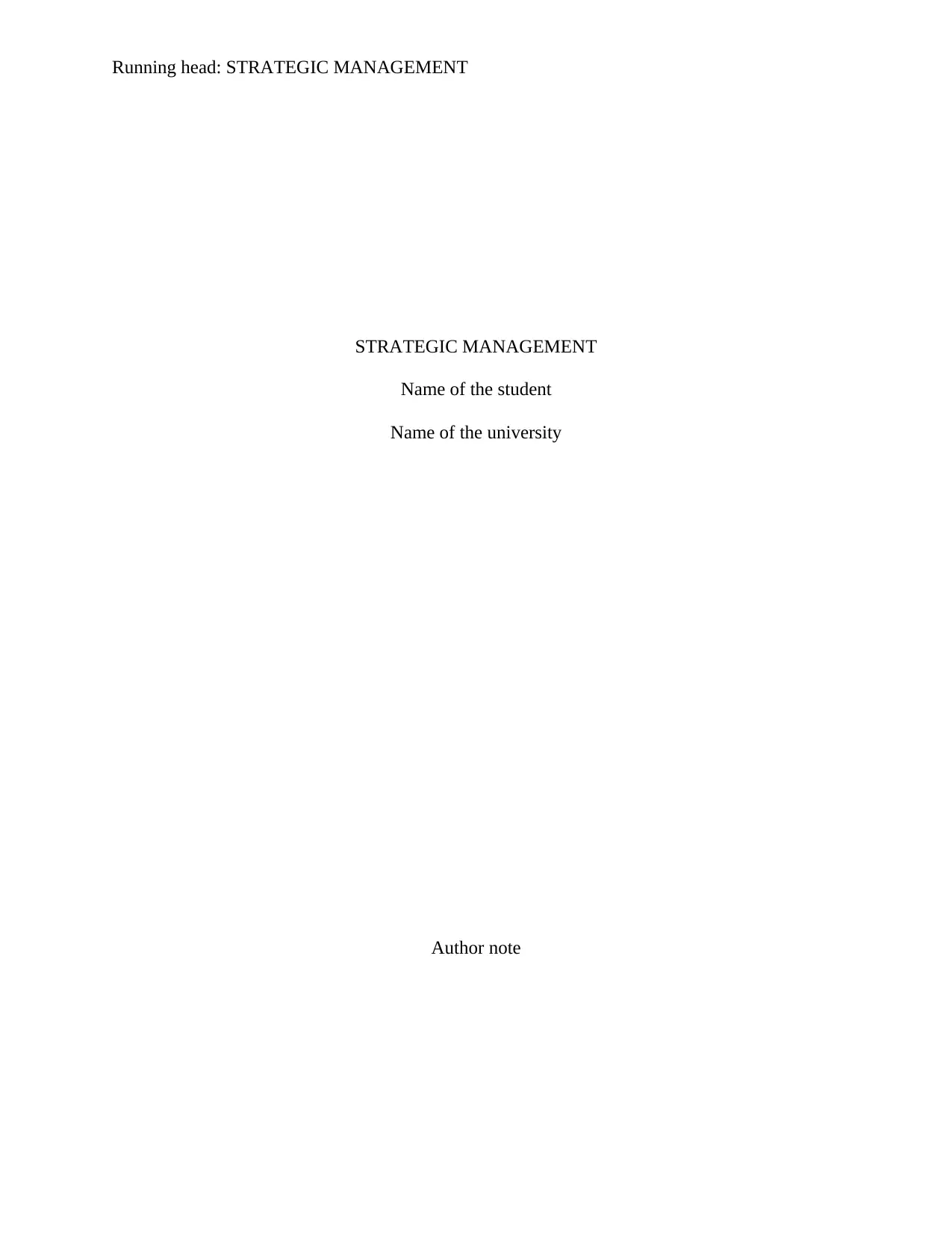
Running head: STRATEGIC MANAGEMENT
STRATEGIC MANAGEMENT
Name of the student
Name of the university
Author note
STRATEGIC MANAGEMENT
Name of the student
Name of the university
Author note
Paraphrase This Document
Need a fresh take? Get an instant paraphrase of this document with our AI Paraphraser
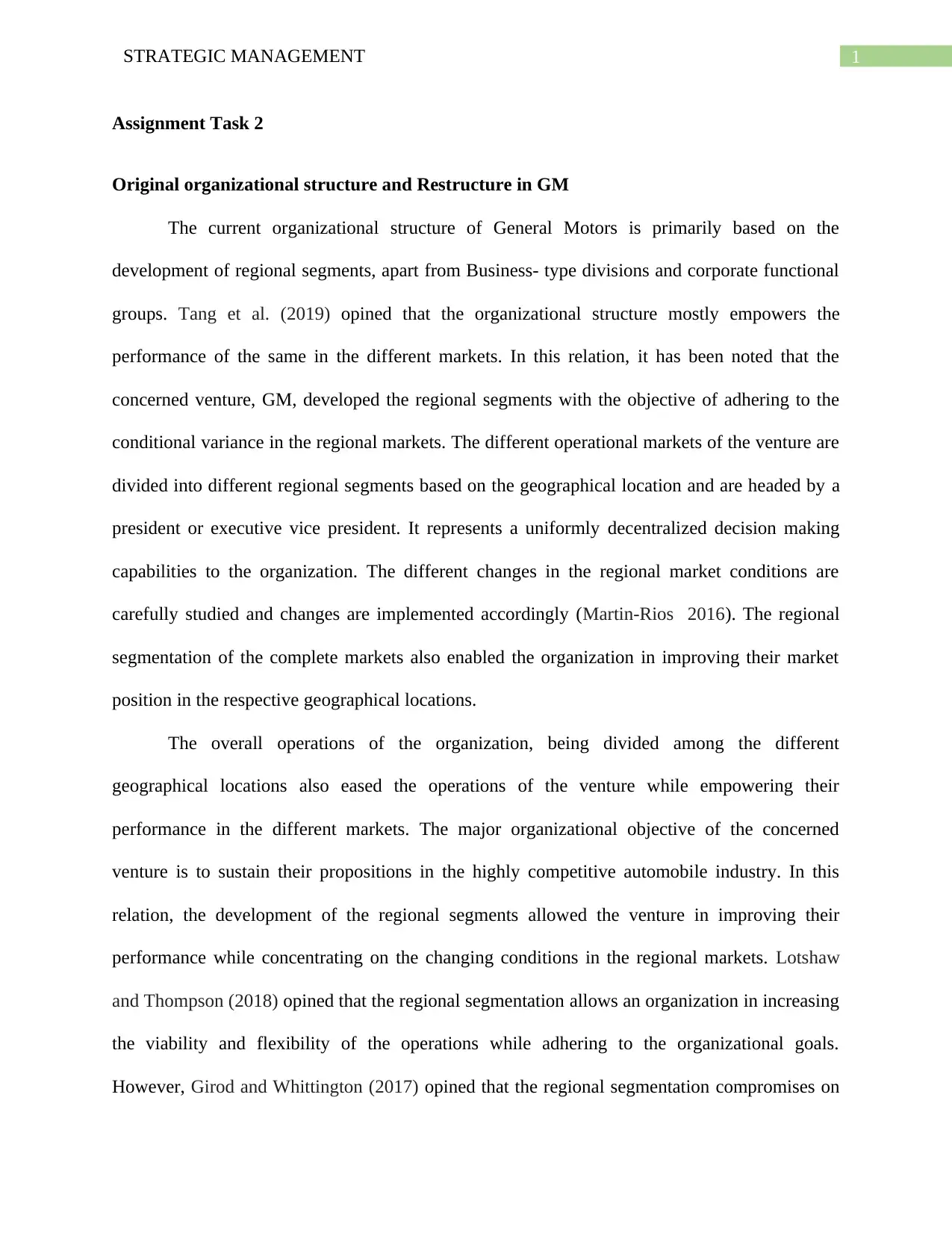
1STRATEGIC MANAGEMENT
Assignment Task 2
Original organizational structure and Restructure in GM
The current organizational structure of General Motors is primarily based on the
development of regional segments, apart from Business- type divisions and corporate functional
groups. Tang et al. (2019) opined that the organizational structure mostly empowers the
performance of the same in the different markets. In this relation, it has been noted that the
concerned venture, GM, developed the regional segments with the objective of adhering to the
conditional variance in the regional markets. The different operational markets of the venture are
divided into different regional segments based on the geographical location and are headed by a
president or executive vice president. It represents a uniformly decentralized decision making
capabilities to the organization. The different changes in the regional market conditions are
carefully studied and changes are implemented accordingly (Martin-Rios 2016). The regional
segmentation of the complete markets also enabled the organization in improving their market
position in the respective geographical locations.
The overall operations of the organization, being divided among the different
geographical locations also eased the operations of the venture while empowering their
performance in the different markets. The major organizational objective of the concerned
venture is to sustain their propositions in the highly competitive automobile industry. In this
relation, the development of the regional segments allowed the venture in improving their
performance while concentrating on the changing conditions in the regional markets. Lotshaw
and Thompson (2018) opined that the regional segmentation allows an organization in increasing
the viability and flexibility of the operations while adhering to the organizational goals.
However, Girod and Whittington (2017) opined that the regional segmentation compromises on
Assignment Task 2
Original organizational structure and Restructure in GM
The current organizational structure of General Motors is primarily based on the
development of regional segments, apart from Business- type divisions and corporate functional
groups. Tang et al. (2019) opined that the organizational structure mostly empowers the
performance of the same in the different markets. In this relation, it has been noted that the
concerned venture, GM, developed the regional segments with the objective of adhering to the
conditional variance in the regional markets. The different operational markets of the venture are
divided into different regional segments based on the geographical location and are headed by a
president or executive vice president. It represents a uniformly decentralized decision making
capabilities to the organization. The different changes in the regional market conditions are
carefully studied and changes are implemented accordingly (Martin-Rios 2016). The regional
segmentation of the complete markets also enabled the organization in improving their market
position in the respective geographical locations.
The overall operations of the organization, being divided among the different
geographical locations also eased the operations of the venture while empowering their
performance in the different markets. The major organizational objective of the concerned
venture is to sustain their propositions in the highly competitive automobile industry. In this
relation, the development of the regional segments allowed the venture in improving their
performance while concentrating on the changing conditions in the regional markets. Lotshaw
and Thompson (2018) opined that the regional segmentation allows an organization in increasing
the viability and flexibility of the operations while adhering to the organizational goals.
However, Girod and Whittington (2017) opined that the regional segmentation compromises on
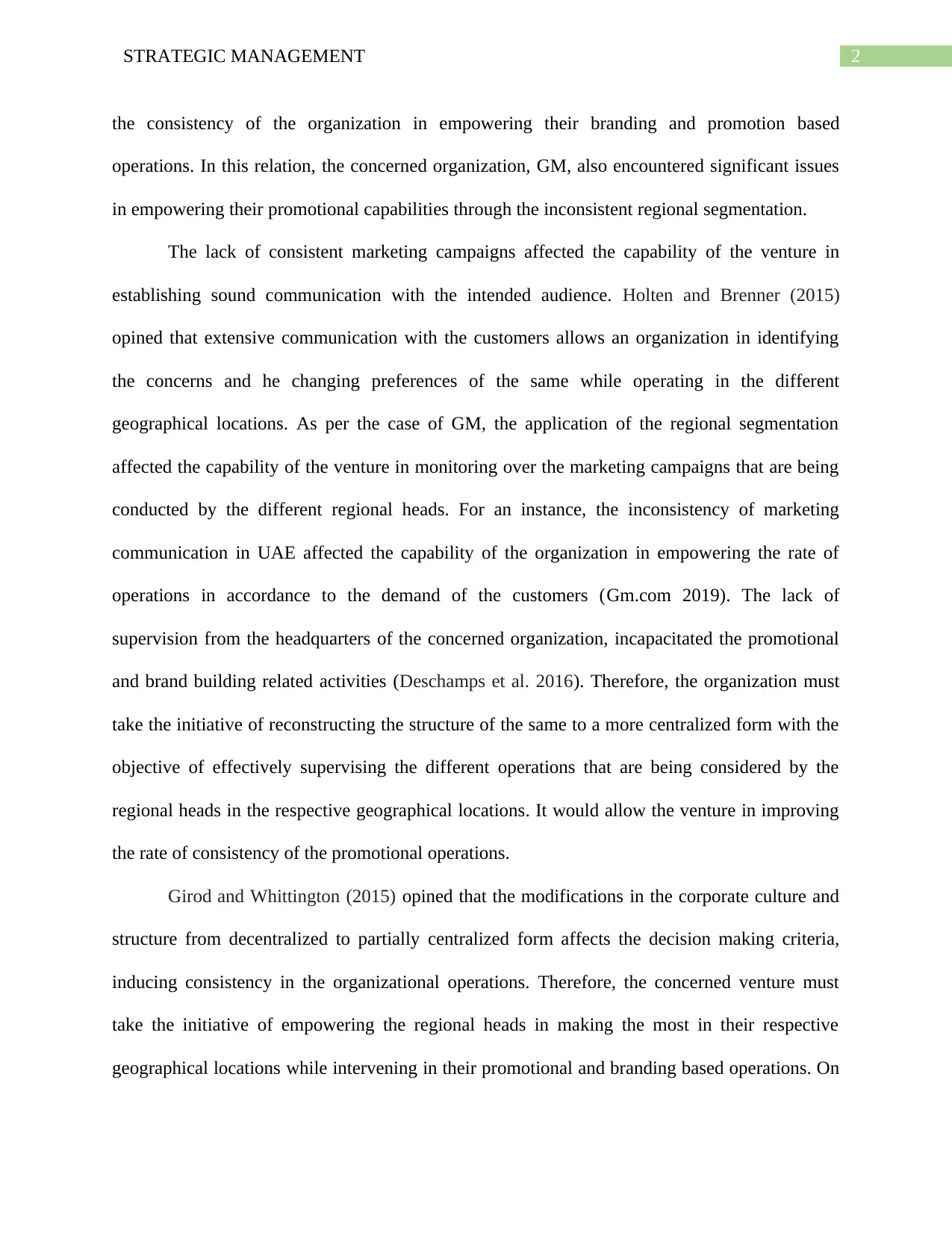
2STRATEGIC MANAGEMENT
the consistency of the organization in empowering their branding and promotion based
operations. In this relation, the concerned organization, GM, also encountered significant issues
in empowering their promotional capabilities through the inconsistent regional segmentation.
The lack of consistent marketing campaigns affected the capability of the venture in
establishing sound communication with the intended audience. Holten and Brenner (2015)
opined that extensive communication with the customers allows an organization in identifying
the concerns and he changing preferences of the same while operating in the different
geographical locations. As per the case of GM, the application of the regional segmentation
affected the capability of the venture in monitoring over the marketing campaigns that are being
conducted by the different regional heads. For an instance, the inconsistency of marketing
communication in UAE affected the capability of the organization in empowering the rate of
operations in accordance to the demand of the customers (Gm.com 2019). The lack of
supervision from the headquarters of the concerned organization, incapacitated the promotional
and brand building related activities (Deschamps et al. 2016). Therefore, the organization must
take the initiative of reconstructing the structure of the same to a more centralized form with the
objective of effectively supervising the different operations that are being considered by the
regional heads in the respective geographical locations. It would allow the venture in improving
the rate of consistency of the promotional operations.
Girod and Whittington (2015) opined that the modifications in the corporate culture and
structure from decentralized to partially centralized form affects the decision making criteria,
inducing consistency in the organizational operations. Therefore, the concerned venture must
take the initiative of empowering the regional heads in making the most in their respective
geographical locations while intervening in their promotional and branding based operations. On
the consistency of the organization in empowering their branding and promotion based
operations. In this relation, the concerned organization, GM, also encountered significant issues
in empowering their promotional capabilities through the inconsistent regional segmentation.
The lack of consistent marketing campaigns affected the capability of the venture in
establishing sound communication with the intended audience. Holten and Brenner (2015)
opined that extensive communication with the customers allows an organization in identifying
the concerns and he changing preferences of the same while operating in the different
geographical locations. As per the case of GM, the application of the regional segmentation
affected the capability of the venture in monitoring over the marketing campaigns that are being
conducted by the different regional heads. For an instance, the inconsistency of marketing
communication in UAE affected the capability of the organization in empowering the rate of
operations in accordance to the demand of the customers (Gm.com 2019). The lack of
supervision from the headquarters of the concerned organization, incapacitated the promotional
and brand building related activities (Deschamps et al. 2016). Therefore, the organization must
take the initiative of reconstructing the structure of the same to a more centralized form with the
objective of effectively supervising the different operations that are being considered by the
regional heads in the respective geographical locations. It would allow the venture in improving
the rate of consistency of the promotional operations.
Girod and Whittington (2015) opined that the modifications in the corporate culture and
structure from decentralized to partially centralized form affects the decision making criteria,
inducing consistency in the organizational operations. Therefore, the concerned venture must
take the initiative of empowering the regional heads in making the most in their respective
geographical locations while intervening in their promotional and branding based operations. On
⊘ This is a preview!⊘
Do you want full access?
Subscribe today to unlock all pages.

Trusted by 1+ million students worldwide
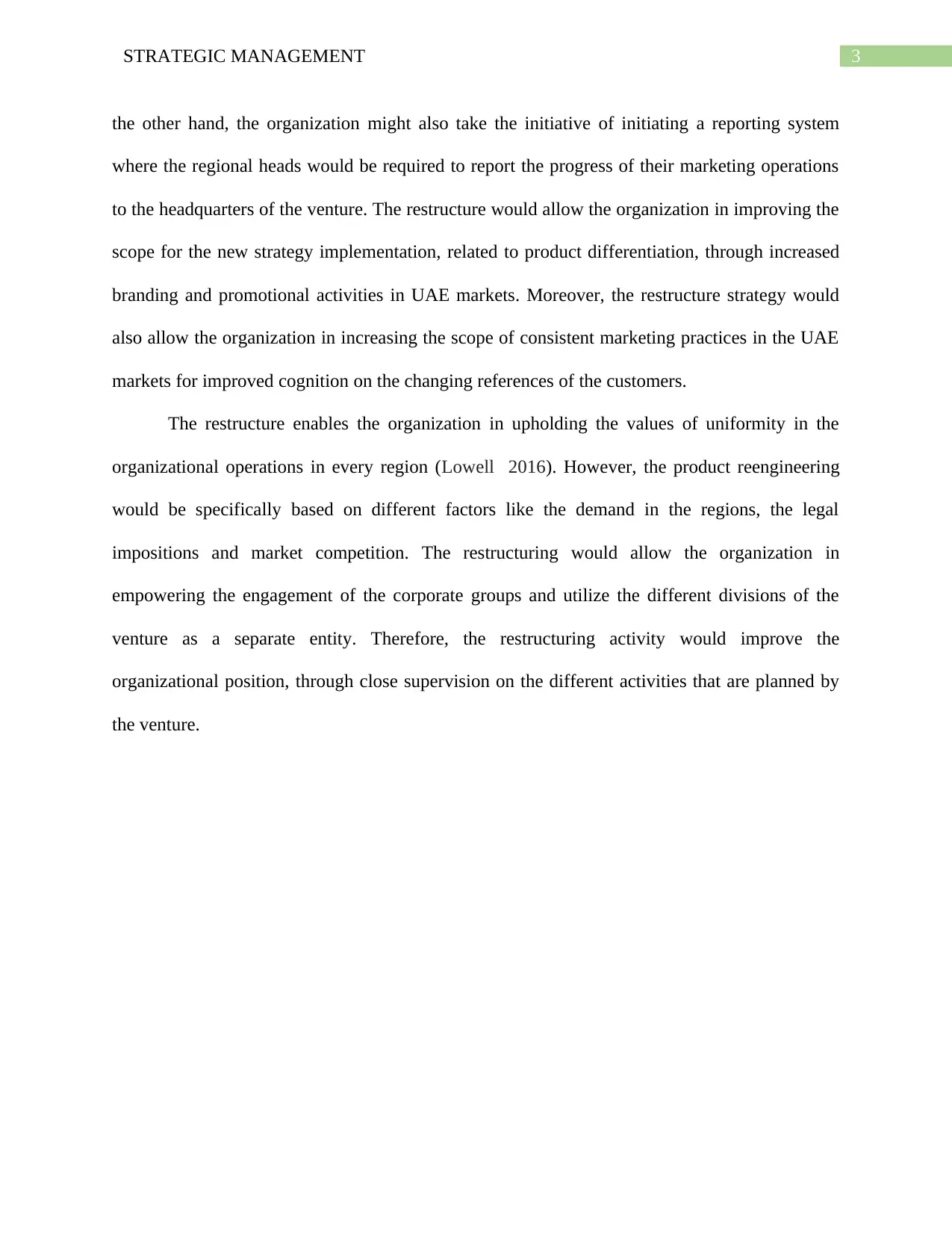
3STRATEGIC MANAGEMENT
the other hand, the organization might also take the initiative of initiating a reporting system
where the regional heads would be required to report the progress of their marketing operations
to the headquarters of the venture. The restructure would allow the organization in improving the
scope for the new strategy implementation, related to product differentiation, through increased
branding and promotional activities in UAE markets. Moreover, the restructure strategy would
also allow the organization in increasing the scope of consistent marketing practices in the UAE
markets for improved cognition on the changing references of the customers.
The restructure enables the organization in upholding the values of uniformity in the
organizational operations in every region (Lowell 2016). However, the product reengineering
would be specifically based on different factors like the demand in the regions, the legal
impositions and market competition. The restructuring would allow the organization in
empowering the engagement of the corporate groups and utilize the different divisions of the
venture as a separate entity. Therefore, the restructuring activity would improve the
organizational position, through close supervision on the different activities that are planned by
the venture.
the other hand, the organization might also take the initiative of initiating a reporting system
where the regional heads would be required to report the progress of their marketing operations
to the headquarters of the venture. The restructure would allow the organization in improving the
scope for the new strategy implementation, related to product differentiation, through increased
branding and promotional activities in UAE markets. Moreover, the restructure strategy would
also allow the organization in increasing the scope of consistent marketing practices in the UAE
markets for improved cognition on the changing references of the customers.
The restructure enables the organization in upholding the values of uniformity in the
organizational operations in every region (Lowell 2016). However, the product reengineering
would be specifically based on different factors like the demand in the regions, the legal
impositions and market competition. The restructuring would allow the organization in
empowering the engagement of the corporate groups and utilize the different divisions of the
venture as a separate entity. Therefore, the restructuring activity would improve the
organizational position, through close supervision on the different activities that are planned by
the venture.
Paraphrase This Document
Need a fresh take? Get an instant paraphrase of this document with our AI Paraphraser
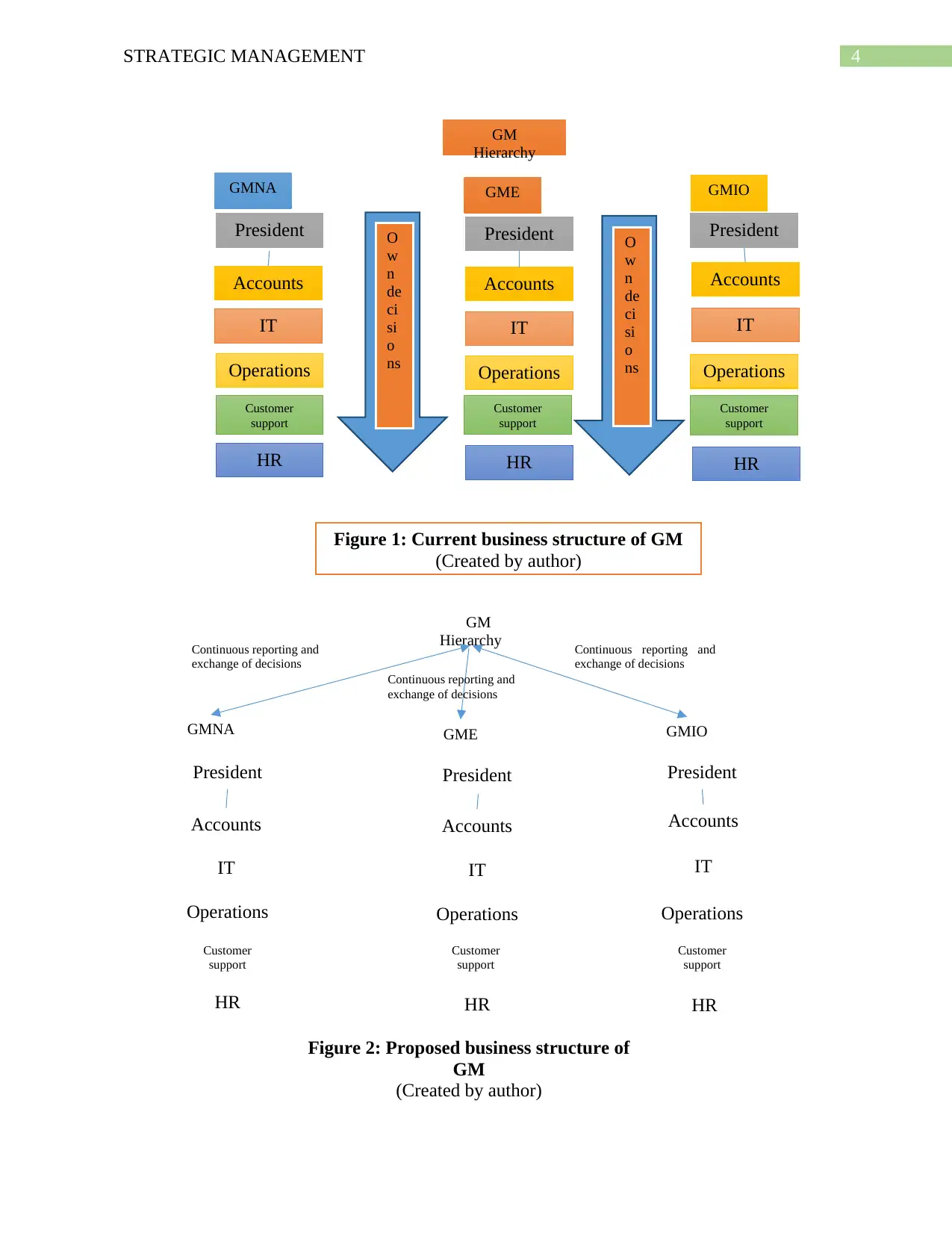
4STRATEGIC MANAGEMENT
GM
Hierarchy
President
Accounts
IT
Operations
Customer
support
HR
President
Accounts
IT
Operations
Customer
support
HR
President
Accounts
IT
Operations
Customer
support
HR
GMNA GME GMIO
O
w
n
de
ci
si
o
ns
O
w
n
de
ci
si
o
ns
Figure 1: Current business structure of GM
(Created by author)
GM
Hierarchy
President
Accounts
IT
Operations
Customer
support
HR
President
Accounts
IT
Operations
Customer
support
HR
President
Accounts
IT
Operations
Customer
support
HR
GMNA GME GMIO
Figure 2: Proposed business structure of
GM
(Created by author)
Continuous reporting and
exchange of decisions
Continuous reporting and
exchange of decisions
Continuous reporting and
exchange of decisions
GM
Hierarchy
President
Accounts
IT
Operations
Customer
support
HR
President
Accounts
IT
Operations
Customer
support
HR
President
Accounts
IT
Operations
Customer
support
HR
GMNA GME GMIO
O
w
n
de
ci
si
o
ns
O
w
n
de
ci
si
o
ns
Figure 1: Current business structure of GM
(Created by author)
GM
Hierarchy
President
Accounts
IT
Operations
Customer
support
HR
President
Accounts
IT
Operations
Customer
support
HR
President
Accounts
IT
Operations
Customer
support
HR
GMNA GME GMIO
Figure 2: Proposed business structure of
GM
(Created by author)
Continuous reporting and
exchange of decisions
Continuous reporting and
exchange of decisions
Continuous reporting and
exchange of decisions
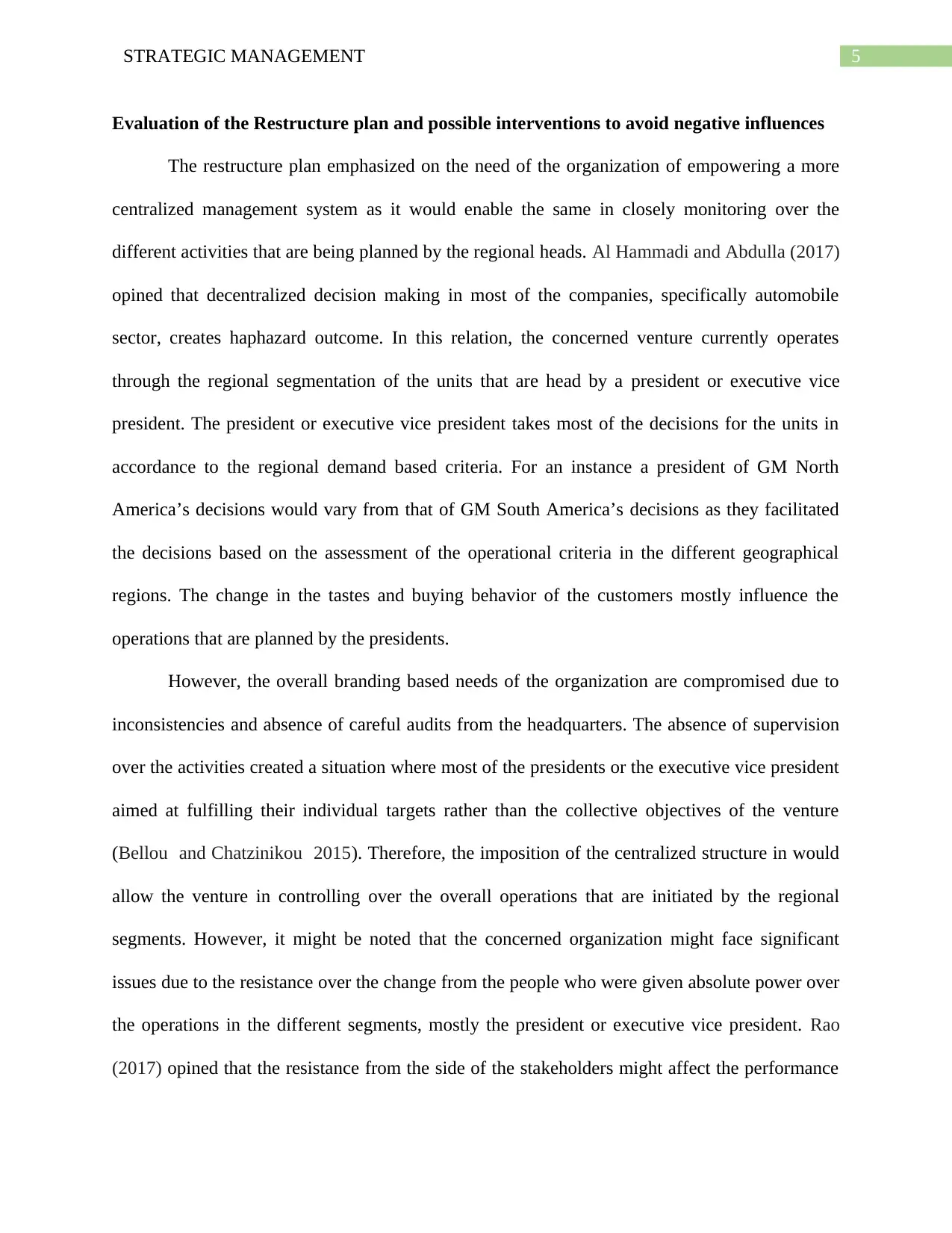
5STRATEGIC MANAGEMENT
Evaluation of the Restructure plan and possible interventions to avoid negative influences
The restructure plan emphasized on the need of the organization of empowering a more
centralized management system as it would enable the same in closely monitoring over the
different activities that are being planned by the regional heads. Al Hammadi and Abdulla (2017)
opined that decentralized decision making in most of the companies, specifically automobile
sector, creates haphazard outcome. In this relation, the concerned venture currently operates
through the regional segmentation of the units that are head by a president or executive vice
president. The president or executive vice president takes most of the decisions for the units in
accordance to the regional demand based criteria. For an instance a president of GM North
America’s decisions would vary from that of GM South America’s decisions as they facilitated
the decisions based on the assessment of the operational criteria in the different geographical
regions. The change in the tastes and buying behavior of the customers mostly influence the
operations that are planned by the presidents.
However, the overall branding based needs of the organization are compromised due to
inconsistencies and absence of careful audits from the headquarters. The absence of supervision
over the activities created a situation where most of the presidents or the executive vice president
aimed at fulfilling their individual targets rather than the collective objectives of the venture
(Bellou and Chatzinikou 2015). Therefore, the imposition of the centralized structure in would
allow the venture in controlling over the overall operations that are initiated by the regional
segments. However, it might be noted that the concerned organization might face significant
issues due to the resistance over the change from the people who were given absolute power over
the operations in the different segments, mostly the president or executive vice president. Rao
(2017) opined that the resistance from the side of the stakeholders might affect the performance
Evaluation of the Restructure plan and possible interventions to avoid negative influences
The restructure plan emphasized on the need of the organization of empowering a more
centralized management system as it would enable the same in closely monitoring over the
different activities that are being planned by the regional heads. Al Hammadi and Abdulla (2017)
opined that decentralized decision making in most of the companies, specifically automobile
sector, creates haphazard outcome. In this relation, the concerned venture currently operates
through the regional segmentation of the units that are head by a president or executive vice
president. The president or executive vice president takes most of the decisions for the units in
accordance to the regional demand based criteria. For an instance a president of GM North
America’s decisions would vary from that of GM South America’s decisions as they facilitated
the decisions based on the assessment of the operational criteria in the different geographical
regions. The change in the tastes and buying behavior of the customers mostly influence the
operations that are planned by the presidents.
However, the overall branding based needs of the organization are compromised due to
inconsistencies and absence of careful audits from the headquarters. The absence of supervision
over the activities created a situation where most of the presidents or the executive vice president
aimed at fulfilling their individual targets rather than the collective objectives of the venture
(Bellou and Chatzinikou 2015). Therefore, the imposition of the centralized structure in would
allow the venture in controlling over the overall operations that are initiated by the regional
segments. However, it might be noted that the concerned organization might face significant
issues due to the resistance over the change from the people who were given absolute power over
the operations in the different segments, mostly the president or executive vice president. Rao
(2017) opined that the resistance from the side of the stakeholders might affect the performance
⊘ This is a preview!⊘
Do you want full access?
Subscribe today to unlock all pages.

Trusted by 1+ million students worldwide
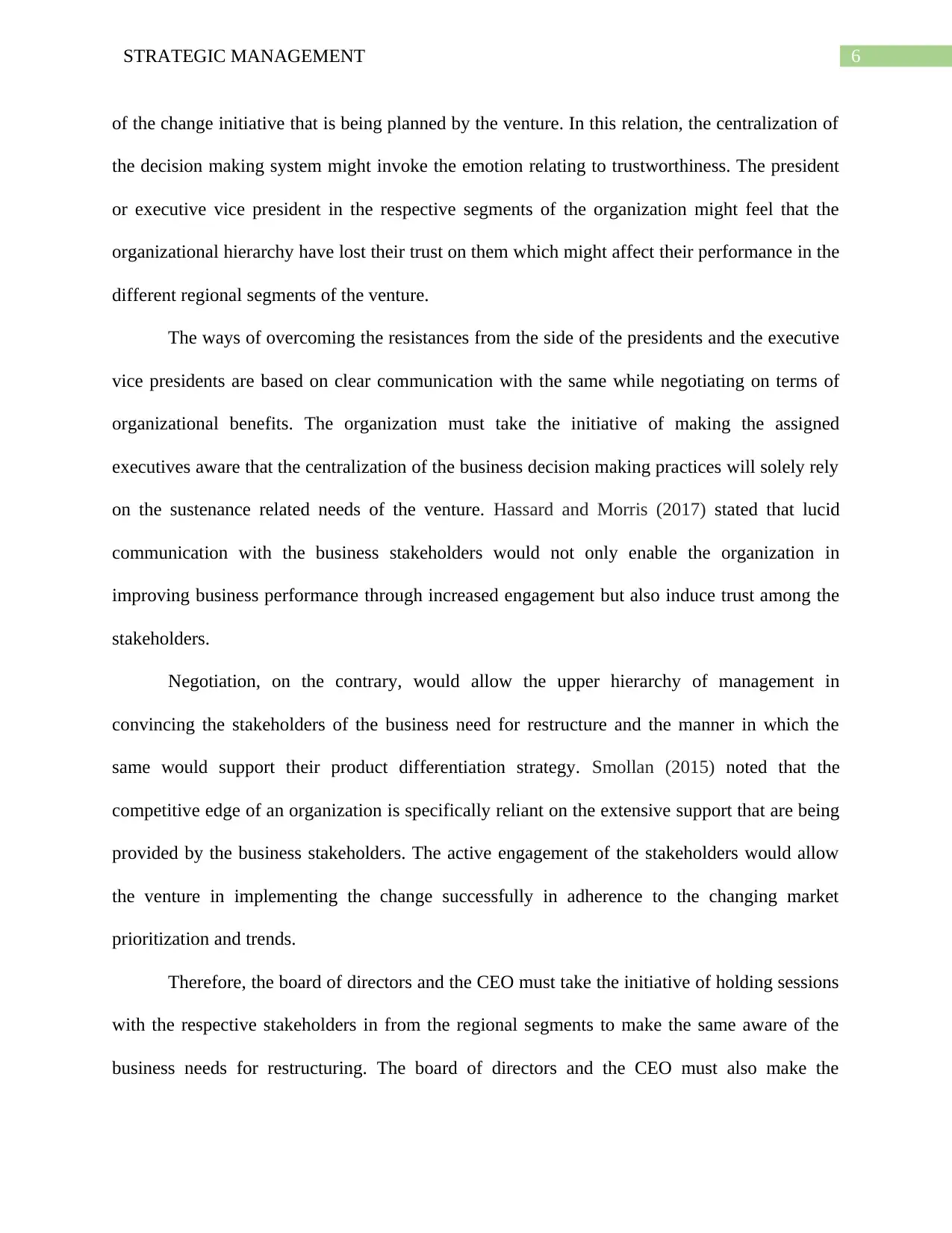
6STRATEGIC MANAGEMENT
of the change initiative that is being planned by the venture. In this relation, the centralization of
the decision making system might invoke the emotion relating to trustworthiness. The president
or executive vice president in the respective segments of the organization might feel that the
organizational hierarchy have lost their trust on them which might affect their performance in the
different regional segments of the venture.
The ways of overcoming the resistances from the side of the presidents and the executive
vice presidents are based on clear communication with the same while negotiating on terms of
organizational benefits. The organization must take the initiative of making the assigned
executives aware that the centralization of the business decision making practices will solely rely
on the sustenance related needs of the venture. Hassard and Morris (2017) stated that lucid
communication with the business stakeholders would not only enable the organization in
improving business performance through increased engagement but also induce trust among the
stakeholders.
Negotiation, on the contrary, would allow the upper hierarchy of management in
convincing the stakeholders of the business need for restructure and the manner in which the
same would support their product differentiation strategy. Smollan (2015) noted that the
competitive edge of an organization is specifically reliant on the extensive support that are being
provided by the business stakeholders. The active engagement of the stakeholders would allow
the venture in implementing the change successfully in adherence to the changing market
prioritization and trends.
Therefore, the board of directors and the CEO must take the initiative of holding sessions
with the respective stakeholders in from the regional segments to make the same aware of the
business needs for restructuring. The board of directors and the CEO must also make the
of the change initiative that is being planned by the venture. In this relation, the centralization of
the decision making system might invoke the emotion relating to trustworthiness. The president
or executive vice president in the respective segments of the organization might feel that the
organizational hierarchy have lost their trust on them which might affect their performance in the
different regional segments of the venture.
The ways of overcoming the resistances from the side of the presidents and the executive
vice presidents are based on clear communication with the same while negotiating on terms of
organizational benefits. The organization must take the initiative of making the assigned
executives aware that the centralization of the business decision making practices will solely rely
on the sustenance related needs of the venture. Hassard and Morris (2017) stated that lucid
communication with the business stakeholders would not only enable the organization in
improving business performance through increased engagement but also induce trust among the
stakeholders.
Negotiation, on the contrary, would allow the upper hierarchy of management in
convincing the stakeholders of the business need for restructure and the manner in which the
same would support their product differentiation strategy. Smollan (2015) noted that the
competitive edge of an organization is specifically reliant on the extensive support that are being
provided by the business stakeholders. The active engagement of the stakeholders would allow
the venture in implementing the change successfully in adherence to the changing market
prioritization and trends.
Therefore, the board of directors and the CEO must take the initiative of holding sessions
with the respective stakeholders in from the regional segments to make the same aware of the
business needs for restructuring. The board of directors and the CEO must also make the
Paraphrase This Document
Need a fresh take? Get an instant paraphrase of this document with our AI Paraphraser
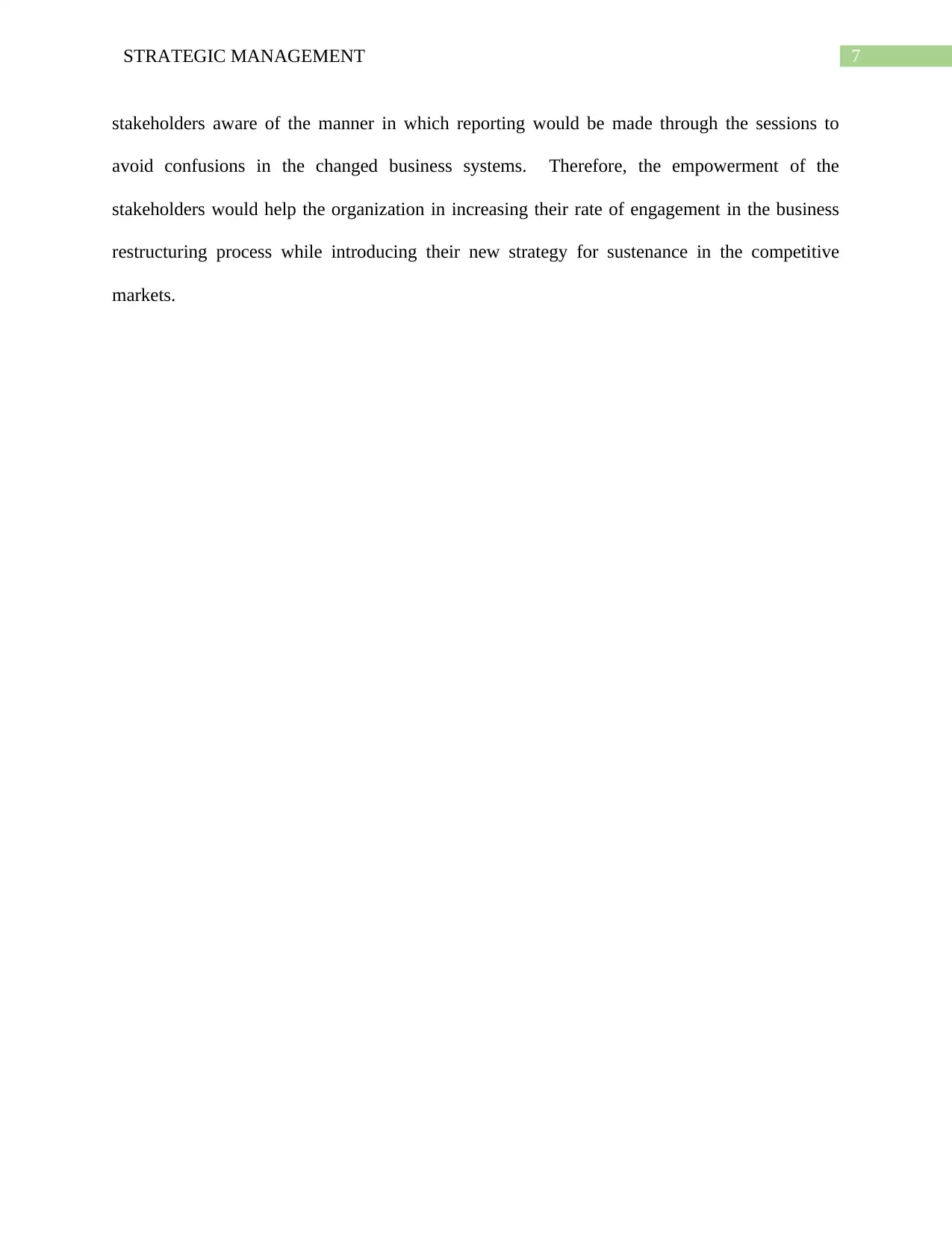
7STRATEGIC MANAGEMENT
stakeholders aware of the manner in which reporting would be made through the sessions to
avoid confusions in the changed business systems. Therefore, the empowerment of the
stakeholders would help the organization in increasing their rate of engagement in the business
restructuring process while introducing their new strategy for sustenance in the competitive
markets.
stakeholders aware of the manner in which reporting would be made through the sessions to
avoid confusions in the changed business systems. Therefore, the empowerment of the
stakeholders would help the organization in increasing their rate of engagement in the business
restructuring process while introducing their new strategy for sustenance in the competitive
markets.
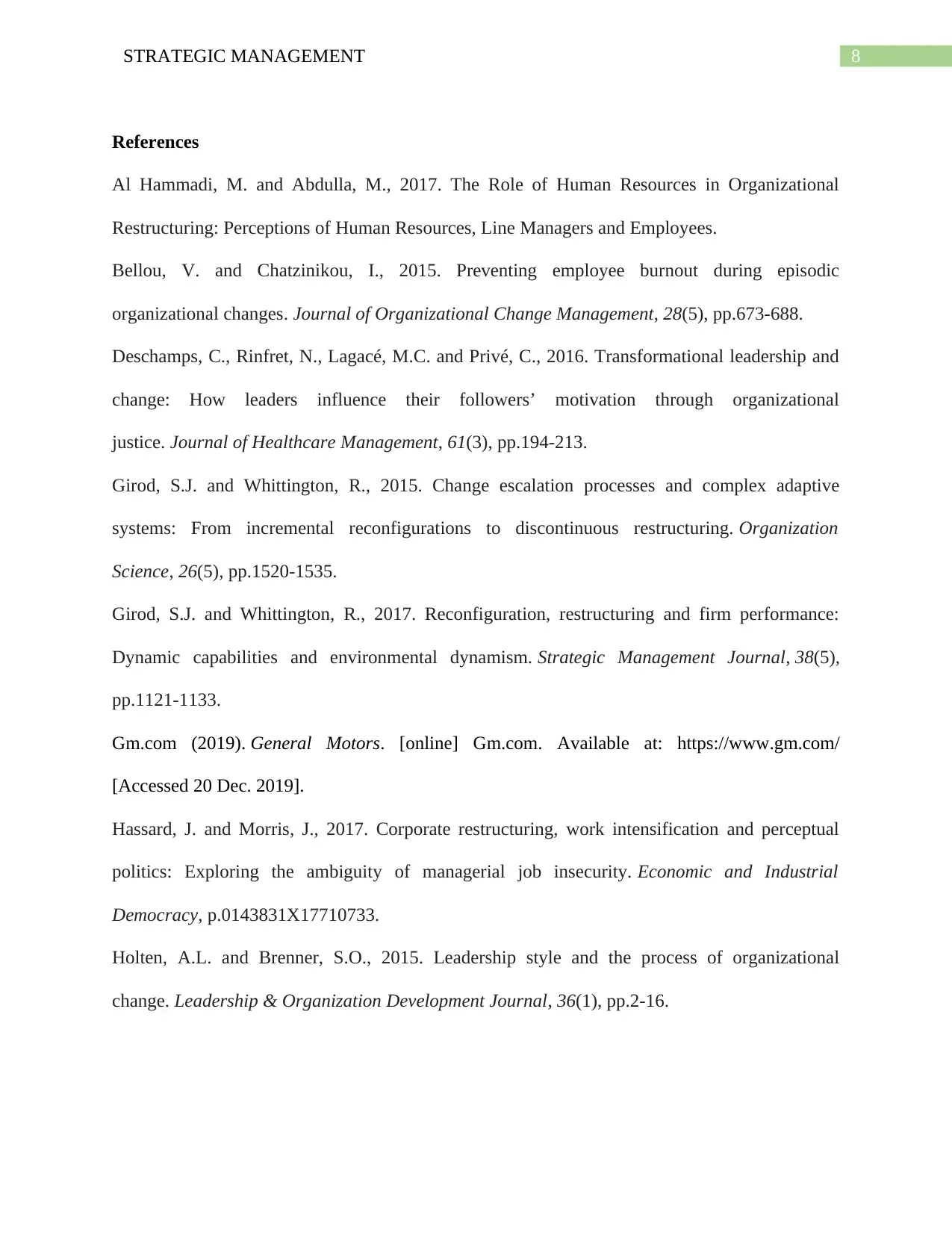
8STRATEGIC MANAGEMENT
References
Al Hammadi, M. and Abdulla, M., 2017. The Role of Human Resources in Organizational
Restructuring: Perceptions of Human Resources, Line Managers and Employees.
Bellou, V. and Chatzinikou, I., 2015. Preventing employee burnout during episodic
organizational changes. Journal of Organizational Change Management, 28(5), pp.673-688.
Deschamps, C., Rinfret, N., Lagacé, M.C. and Privé, C., 2016. Transformational leadership and
change: How leaders influence their followers’ motivation through organizational
justice. Journal of Healthcare Management, 61(3), pp.194-213.
Girod, S.J. and Whittington, R., 2015. Change escalation processes and complex adaptive
systems: From incremental reconfigurations to discontinuous restructuring. Organization
Science, 26(5), pp.1520-1535.
Girod, S.J. and Whittington, R., 2017. Reconfiguration, restructuring and firm performance:
Dynamic capabilities and environmental dynamism. Strategic Management Journal, 38(5),
pp.1121-1133.
Gm.com (2019). General Motors. [online] Gm.com. Available at: https://www.gm.com/
[Accessed 20 Dec. 2019].
Hassard, J. and Morris, J., 2017. Corporate restructuring, work intensification and perceptual
politics: Exploring the ambiguity of managerial job insecurity. Economic and Industrial
Democracy, p.0143831X17710733.
Holten, A.L. and Brenner, S.O., 2015. Leadership style and the process of organizational
change. Leadership & Organization Development Journal, 36(1), pp.2-16.
References
Al Hammadi, M. and Abdulla, M., 2017. The Role of Human Resources in Organizational
Restructuring: Perceptions of Human Resources, Line Managers and Employees.
Bellou, V. and Chatzinikou, I., 2015. Preventing employee burnout during episodic
organizational changes. Journal of Organizational Change Management, 28(5), pp.673-688.
Deschamps, C., Rinfret, N., Lagacé, M.C. and Privé, C., 2016. Transformational leadership and
change: How leaders influence their followers’ motivation through organizational
justice. Journal of Healthcare Management, 61(3), pp.194-213.
Girod, S.J. and Whittington, R., 2015. Change escalation processes and complex adaptive
systems: From incremental reconfigurations to discontinuous restructuring. Organization
Science, 26(5), pp.1520-1535.
Girod, S.J. and Whittington, R., 2017. Reconfiguration, restructuring and firm performance:
Dynamic capabilities and environmental dynamism. Strategic Management Journal, 38(5),
pp.1121-1133.
Gm.com (2019). General Motors. [online] Gm.com. Available at: https://www.gm.com/
[Accessed 20 Dec. 2019].
Hassard, J. and Morris, J., 2017. Corporate restructuring, work intensification and perceptual
politics: Exploring the ambiguity of managerial job insecurity. Economic and Industrial
Democracy, p.0143831X17710733.
Holten, A.L. and Brenner, S.O., 2015. Leadership style and the process of organizational
change. Leadership & Organization Development Journal, 36(1), pp.2-16.
⊘ This is a preview!⊘
Do you want full access?
Subscribe today to unlock all pages.

Trusted by 1+ million students worldwide
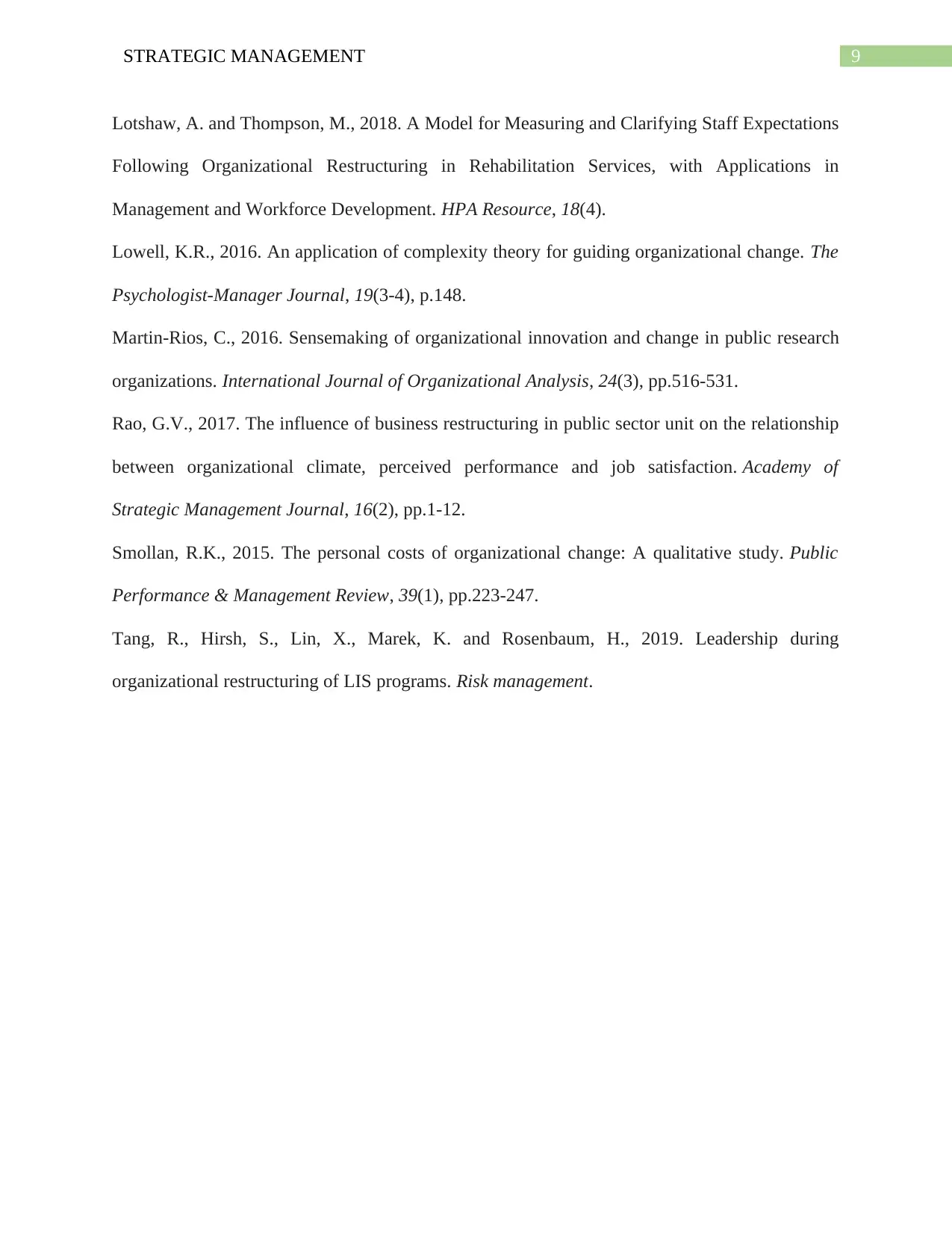
9STRATEGIC MANAGEMENT
Lotshaw, A. and Thompson, M., 2018. A Model for Measuring and Clarifying Staff Expectations
Following Organizational Restructuring in Rehabilitation Services, with Applications in
Management and Workforce Development. HPA Resource, 18(4).
Lowell, K.R., 2016. An application of complexity theory for guiding organizational change. The
Psychologist-Manager Journal, 19(3-4), p.148.
Martin-Rios, C., 2016. Sensemaking of organizational innovation and change in public research
organizations. International Journal of Organizational Analysis, 24(3), pp.516-531.
Rao, G.V., 2017. The influence of business restructuring in public sector unit on the relationship
between organizational climate, perceived performance and job satisfaction. Academy of
Strategic Management Journal, 16(2), pp.1-12.
Smollan, R.K., 2015. The personal costs of organizational change: A qualitative study. Public
Performance & Management Review, 39(1), pp.223-247.
Tang, R., Hirsh, S., Lin, X., Marek, K. and Rosenbaum, H., 2019. Leadership during
organizational restructuring of LIS programs. Risk management.
Lotshaw, A. and Thompson, M., 2018. A Model for Measuring and Clarifying Staff Expectations
Following Organizational Restructuring in Rehabilitation Services, with Applications in
Management and Workforce Development. HPA Resource, 18(4).
Lowell, K.R., 2016. An application of complexity theory for guiding organizational change. The
Psychologist-Manager Journal, 19(3-4), p.148.
Martin-Rios, C., 2016. Sensemaking of organizational innovation and change in public research
organizations. International Journal of Organizational Analysis, 24(3), pp.516-531.
Rao, G.V., 2017. The influence of business restructuring in public sector unit on the relationship
between organizational climate, perceived performance and job satisfaction. Academy of
Strategic Management Journal, 16(2), pp.1-12.
Smollan, R.K., 2015. The personal costs of organizational change: A qualitative study. Public
Performance & Management Review, 39(1), pp.223-247.
Tang, R., Hirsh, S., Lin, X., Marek, K. and Rosenbaum, H., 2019. Leadership during
organizational restructuring of LIS programs. Risk management.
Paraphrase This Document
Need a fresh take? Get an instant paraphrase of this document with our AI Paraphraser

10STRATEGIC MANAGEMENT
1 out of 11
Related Documents
Your All-in-One AI-Powered Toolkit for Academic Success.
+13062052269
info@desklib.com
Available 24*7 on WhatsApp / Email
![[object Object]](/_next/static/media/star-bottom.7253800d.svg)
Unlock your academic potential
Copyright © 2020–2025 A2Z Services. All Rights Reserved. Developed and managed by ZUCOL.





